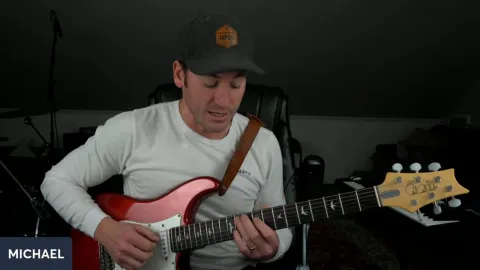I went with a 1,4,5 progression in the key of E and tried to connect triads with the linear pentatonic runs. This helps me move in and out of chord shapes and it gives a smooth sound. It also keeps me from getting lost when I use the shapes as reference points. You can just launch into the linear scale from the triad…especially the A shape. Loving these lessons Micheal!!!
Essential Major Melodies

In this masterclass, Michael Palmisano delves into the concept of essential major melodies on the guitar, emphasizing the importance of melody in connection with harmony. He begins by demonstrating how guitar players often get lost in scales, playing in a certain key without truly connecting their playing to the underlying chords. Michael challenges this approach by encouraging viewers to think beyond scales and focus on creating melodies that resonate with the harmony. He uses a loop in B major to illustrate his point, encouraging participants to play along and create their own melodies using a basic major pentatonic approach.
Throughout the video, Michael provides practical exercises to help viewers understand the relationship between melody and harmony. He simplifies the process by breaking it down into octave shapes, chord shapes, and triads. By focusing on playing a basic major melody over moving major chords, Michael demonstrates how to make music more melodic and harmonically connected. He emphasizes the importance of playing melodies linearly rather than just running through scales, using the major pentatonic scale as a foundation for creating memorable melodies. The masterclass is interactive, with Michael actively engaging with viewers, answering questions, and addressing any confusion regarding the lesson's content.
By the end of the masterclass, viewers gain a deeper understanding of how to create essential major melodies that enhance the harmonic content of their music. Michael's approachable teaching style and practical exercises provide guitarists with the tools they need to improve their melodic playing. The lesson highlights the importance of connecting melody with harmony, encouraging guitar players to explore beyond scale patterns and think more musically. This masterclass is an essential resource for guitarists looking to add more melodic depth to their playing and better understand the relationship between chords and melodies.
Sorry for the booming sound when I play the lower strings. I didn't realize how loud they were. I'll try and figure out how to compress those notes.
I think it started out shaky, but towards the middle I started to get in a groove and was really happy with how I was flowing. I give a recap of how I thought the playing went at the end.
- Introduction and Theme Overview (00:00:02 - 00:04:26)
- Michael greets viewers and introduces the lesson theme: essential major melodies.
- He demonstrates playing a loop in B major, encouraging viewers to play along.
- Technical issues are briefly addressed before moving on to the main content.
- Major Melody Essentials (00:04:26 - 00:10:26)
- Michael emphasizes the importance of understanding how melodies integrate with harmony.
- He discusses common pitfalls guitar players face, such as over-reliance on scales.
- The lesson focuses on constructing melodies using the major pentatonic scale pattern.
- Practical Exercise Setup (00:10:26 - 00:15:25)
- Michael introduces a practical exercise using a B major to A major progression.
- He demonstrates how to play a basic major melody over these chords.
- The exercise is designed to encourage playing melodies linearly rather than relying on scale patterns.
- Expanding Melodic Concepts (00:15:25 - 00:20:30)
- The lesson expands to include E major, challenging viewers to adapt the melody.
- Michael illustrates how to navigate the fretboard more efficiently by understanding the relationship between chords and major pentatonic shapes.
- Viewers are encouraged to experiment with creating their own melodic lines within the given chord progression.
- Applying Theory to Practice (00:20:30 - 00:25:35)
- Michael explains the theoretical underpinnings of the exercise, relating chord progressions to modal theory and pentatonic scales.
- He reassures viewers that focusing on chord tones simplifies the process of improvisation and melody creation.
- The discussion covers how pentatonic scales inherently avoid dissonant notes, making them versatile for crafting melodies.
- Interactive Q&A and Summary (00:25:35 - 00:50:35)
- Michael opens the floor to questions, providing clarifications on the lesson's content.
- He reinforces the value of simplicity in music, encouraging viewers to focus on melody and harmony rather than complex theory.
- The session concludes with a reminder of the importance of practice and experimentation for internalizing these concepts.
